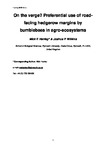On the verge? Preferential use of road-facing hedgerow margins by bumblebees in agro-ecosystems
| dc.contributor.author | Furtado Frota, Francisco Gabriel | |
| dc.contributor.author | Wilkins, JP | |
| dc.date.accessioned | 2016-03-23T15:45:30Z | |
| dc.date.available | 2016-03-23T15:45:30Z | |
| dc.date.issued | 2015-02 | |
| dc.identifier.issn | 1366-638X | |
| dc.identifier.issn | 1572-9753 | |
| dc.identifier.uri | http://hdl.handle.net/10026.1/4401 | |
| dc.description.abstract |
The global pollinator decline is commonly linked to modern intensive farming practices, partly because excessive herbicide and fertilizer use is thought to reduce pollinator food plant availability. This effect is particularly obvious across crop-/non-crop boundaries, but no study has compared pollinator and food plant abundance on adjacent crop- and roadside margins. We compared bumblebee abundance along 30 hedgerows in SW England; bordered either side by roads and arable fields (cultivated with wheat, barley, oilseed rape, or beans). Total bumblebee abundance along roadsides was over twice that observed on adjacent crop-facing margins, irrespective of crop type and this general pattern was apparent for three of the five most common bumblebee species, including generalist and specialist foragers. Both the total number of flowering plant species and the floral abundance of three of the five most visited plants was also higher on roadsides; minor variation between-crops was localised and unrelated to margin orientation. We conclude that organic farming may offer some advantages for pollinator conservation since it reduces field margin exposure to agro-chemical inputs. However, since conventional farming will remain central to global food production, modifications to current practices (such as the use of wildflower strips) are needed and may have ancillary benefits for pollinators by protecting arable margins from disturbance and agro-chemicals. In addition, the fact that the roadsides were demonstrably better habitats for pollinators and their food plants than field-facing margins underscores the widespread suggestion that roadside verges should be utilised more as a conservation tool to promote pollinator biodiversity. | |
| dc.format.extent | 67-74 | |
| dc.language | en | |
| dc.language.iso | en | |
| dc.publisher | Springer Science and Business Media LLC | |
| dc.subject | Agricultural intensification | |
| dc.subject | Ecosystem services | |
| dc.subject | Environmental stewardship schemes | |
| dc.subject | Field margins | |
| dc.subject | Pesticides | |
| dc.subject | Pollinators | |
| dc.title | On the verge? Preferential use of road-facing hedgerow margins by bumblebees in agro-ecosystems | |
| dc.type | journal-article | |
| dc.type | Journal Article | |
| plymouth.author-url | https://www.webofscience.com/api/gateway?GWVersion=2&SrcApp=PARTNER_APP&SrcAuth=LinksAMR&KeyUT=WOS:000350887700007&DestLinkType=FullRecord&DestApp=ALL_WOS&UsrCustomerID=11bb513d99f797142bcfeffcc58ea008 | |
| plymouth.issue | 1 | |
| plymouth.volume | 19 | |
| plymouth.publication-status | Published | |
| plymouth.journal | Journal of Insect Conservation | |
| dc.identifier.doi | 10.1007/s10841-014-9744-3 | |
| plymouth.organisational-group | /Plymouth | |
| plymouth.organisational-group | /Plymouth/Faculty of Science and Engineering | |
| plymouth.organisational-group | /Plymouth/Faculty of Science and Engineering/School of Biological and Marine Sciences | |
| plymouth.organisational-group | /Plymouth/REF 2021 Researchers by UoA | |
| plymouth.organisational-group | /Plymouth/REF 2021 Researchers by UoA/UoA06 Agriculture, Veterinary and Food Science | |
| plymouth.organisational-group | /Plymouth/Users by role | |
| plymouth.organisational-group | /Plymouth/Users by role/Academics | |
| dc.identifier.eissn | 1572-9753 | |
| dc.rights.embargoperiod | Not known | |
| rioxxterms.versionofrecord | 10.1007/s10841-014-9744-3 | |
| rioxxterms.licenseref.uri | http://www.rioxx.net/licenses/all-rights-reserved | |
| rioxxterms.type | Journal Article/Review |


